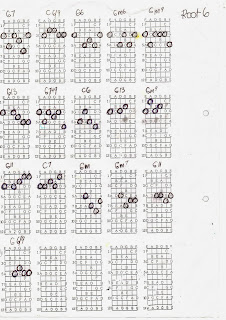This will be hard at first but very beneficial for your playing. Experiment with the alternate up and down strokes sometimes doing two downs to end on an up stoke to bring you back to the low string works well. With practise it will not matter what way you do it. Repeat the phases. Use any chords, muted open chords are a little easier.
---------------------3-----------------3---------------------3------------------------3------------------------------
---------------3----------------3--------------------3----------------------3-----------------------------------------
-------------------------------------------------------------------------------------------------------------------------
----------------------------------------------5----------------------------------------------------------------------
--------------------------5-----------------------------------------5--------------------------------------------------
--------3-----------------------------------------------------------------------------------------------------------------
----------------3-----------------3------------------3--------------------3------------------------------------------
-----------------------3---------------3----------------------3---------------------3--------------------------------
--------------------------------------------------------------------------------------------------------------------
-----------------------------------------------5---------------------------------------------------------------------
----------------------------5-----------------------------------------5----------------------------------------------
--------3-----------------------------------------------------------------------------------------------------------
-----------------------------------------------------------------------------------------------------------------------
-------------------------------------------------------------------------------3--------------------------------------
-------------------------------------------------4-------------------4-----------------------------------4------------
-----------------------5-----------------5------------------5----------------------------------5----------------------
----------------5----------------5---------------------------------------------------5--------------------------------
--------3------------------------------------------------------------------------------------------------------------
-------------------------3------------------------------------------------------------------------------------------------
-------------------------------------------------------------------------------------------------------------------------
---------------------------------------------4----------------------------------------------------------------------------
----------------5---------------------5------------------------------------------------------------------------------------
-----------------------------5--------------------------------------------------------------------------------------------
---------3----------------------------------------------------------------------------------------------------------------
---------------------------------3-----------------------------------3-------------------------------3------------------
------------------------3-------------3----------------------3-----------3---------------------3--------3--------------
-----------------4-------------------------4---------4-------------------------4----------4------------------4--------
--------------------------------------------------------------------------------------5-----------------------------------
-------------------------------------------------5------------------------------------------------------------------------
---------3----------------------------------------------------------------------------------------------------------------
-------------------------3----------------3-----------------3-------------------------------------------------------------
------------------------------3-----------------3------------------3-------------------------------------------------------
------------------------------------4-----------------4-----------------4--------------------------------------------------
--------------------5--------------------------------------------------------------------------------------------------
----------------5-----------------------------------------------------------------------------------------------------
----------3---------------------------------------------------------------------------------------------------------









